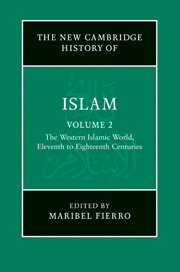Book contents
- Frontmatter
- Introduction
- PART I AL-ANDALUS AND NORTH AND WEST AFRICA (ELEVENTH TO FIFTEENTH CENTURIES)
- PART II EGYPT AND SYRIA (ELEVENTH CENTURY UNTIL THE OTTOMAN CONQUEST)
- PART III MUSLIM ANATOLIA AND THE OTTOMAN EMPIRE
- 10 The Turks in Anatolia before the Ottomans
- 11 The rise of the Ottomans
- 12 The Ottoman empire (tenth/sixteenth century)
- 13 The Ottoman empire: the age of ‘political households’ (eleventh–twelfth/seventeenth–eighteenth centuries)
- 14 Egypt and Syria under the Ottomans
- 15 Western Arabia and Yemen during the Ottoman period
- PART IV NORTH AND WEST AFRICA (SIXTEENTH TO EIGHTEENTH CENTURIES)
- PART V RULERS, SOLDIERS, PEASANTS, SCHOLARS AND TRADERS
- Glossary
- Bibliography
- Index
- References
12 - The Ottoman empire (tenth/sixteenth century)
from PART III - MUSLIM ANATOLIA AND THE OTTOMAN EMPIRE
Published online by Cambridge University Press: 28 March 2011
- Frontmatter
- Introduction
- PART I AL-ANDALUS AND NORTH AND WEST AFRICA (ELEVENTH TO FIFTEENTH CENTURIES)
- PART II EGYPT AND SYRIA (ELEVENTH CENTURY UNTIL THE OTTOMAN CONQUEST)
- PART III MUSLIM ANATOLIA AND THE OTTOMAN EMPIRE
- 10 The Turks in Anatolia before the Ottomans
- 11 The rise of the Ottomans
- 12 The Ottoman empire (tenth/sixteenth century)
- 13 The Ottoman empire: the age of ‘political households’ (eleventh–twelfth/seventeenth–eighteenth centuries)
- 14 Egypt and Syria under the Ottomans
- 15 Western Arabia and Yemen during the Ottoman period
- PART IV NORTH AND WEST AFRICA (SIXTEENTH TO EIGHTEENTH CENTURIES)
- PART V RULERS, SOLDIERS, PEASANTS, SCHOLARS AND TRADERS
- Glossary
- Bibliography
- Index
- References
Summary
Introduction
During the course of the tenth/sixteenth century, the Ottoman empire emerged as a world power, both in terms of its real military and political strength, and in terms of the claims of the Ottoman dynasty to universal sovereignty. During the previous century, Meḥmed II (r. 855–86/1451–81) had consolidated Ottoman control of much of Anatolia and the Balkan Peninsula through conquest and through the removal of local dynasties or their absorption into the Ottoman ruling establishment. This process of assimilation continued during the reign of Meḥmed’s son Bāyezīd II (r. 886–918/1481–1512). Ottoman territory as it stood at the end of Meḥmed II’s reign remained the core territory of the empire during the tenth/sixteenth century and later. Viziers and other members of the military–political class were usually of Rumelian origin, that is from the Balkan Peninsula. It was only during the late tenth/sixteenth and eleventh/seventeenth centuries that men of Caucasian origin emerged as rivals to the Rumelians in the contest for political office. The legal–religious elite tended to come from Anatolian Turkish families, as did the secretaries that manned the sultan’s chancellery. It was also Rumeli and Anatolia that furnished the majority of troops and crews for the imperial army and imperial fleet, and provided most of the materials and cash to support military and naval enterprises. Furthermore, the conquest of Constantinople in 857/1453 and its subsequent rebuilding had provided the empire with a permanent capital situated between Rumeli and Anatolia.
- Type
- Chapter
- Information
- The New Cambridge History of Islam , pp. 332 - 365Publisher: Cambridge University PressPrint publication year: 2010
References
- 1
- Cited by



